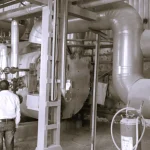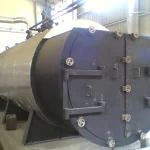High-Efficiency Waste Heat Recovery Boiler – Maximize Energy Savings & Reduce Emissions
Waste heat recovery boiler- Wastetherm
Thermodyne’s premium Waste Heat Recovery Boiler (WHRB) is designed as an energy-efficient solution to convert waste heat from industrial processes into useful steam or hot water—without burning additional fuel. Ideal to pair with DG sets, furnaces, kilns, and incinerators, Wastetherm waste heat recovery boiler helps industries recover valuable heat energy from exhaust gases, leading to zero operating cost and significant fuel savings.
By utilizing otherwise wasted heat, Wastetherm waste heat recovery boiler utilizes the fuel heat to its fullest, lowers carbon emissions, and contributes to a more sustainable and eco-friendly operation. Whether you’re in power, cement, steel, or chemical industries, this system helps you cut energy costs and improve efficiency without any compromise on performance.
Built for reliability and durability, Wastetherm offers a high return on assets (ROA) with a short payback period—making it one of the smartest investments for cost-conscious and environmentally responsible businesses.
The capacity of the waste heat recovery boiler or the amount of heat it can generate depends on the quantity of heat available in the flue gases. This is calculated using flow rate of flue gases leaving the exhaust, flue gas composition or the specific heat of the flue gas, temperature of the wasted flue gas, and the process where this wasted heat is to be utilized. Since all these factors vary differently, tailor-made solutions are offered to achieve the highest level of efficiency.
These waste heat boilers promise ZERO fuel bills to operate and offer handsome payback on your investment.
- Zero fuel requirement = Zero operating cost
- Rapid ROI and long-term savings
- Eco-friendly: No combustion, no emissions
- Custom-designed for your application
- Utilizes energy that would otherwise be wasted
Choose Wastetherm – Save energy, reduce costs, and move towards a sustainable future with Thermodyne’s leading-edge waste heat recovery system.
WHRB related FAQs-
WHRB is an energy-efficient system that captures and utilizes waste heat from industrial processes. This heat is typically lost through flue gases or exhaust and is reused to generate steam or hot water, reducing fuel costs and improving overall efficiency.
There are many reputed waste heat recovery system manufacturers, especially in India. Companies like Thermodyne Engineering Systems provide robust and customized systems that cater to diverse industrial needs, offering high thermal efficiency and low emissions.
The WHRB working principle is based on transferring thermal energy from hot exhaust gases to water or other fluids. The recovered energy is used to produce steam, which can be employed in power generation or industrial processes.
Efficient waste heat recovery systems operation helps recover up to 30% of waste heat, significantly reducing fuel consumption and operating costs in continuous industrial operations.
A heat recovery boiler in cement plant captures heat from kiln and clinker cooler exhaust gases. This recovered energy is then used to produce steam, which can be utilized for other processing.
A waste heat recovery system uses existing waste heat from industrial processes, whereas a traditional boiler burns additional fuel to generate steam. This makes WHRBs more eco-friendly and cost-effective.
Waste heat recovery boiler design depends on factors such as gas composition, flow rate, temperature, pressure requirements, and steam output needed for downstream applications.
Waste Heat Recovery Systems are made as per your need—how much steam you need, what pressure is required, how much space you have, and your plant capacity.





